Kmart Australia
Kmart Australia Limited (/ˈkeɪmɑːrt/ KAY-mart, doing business as Kmart, Kmart Australia, Kmart New Zealand and Kmart Australia And New Zealand and stylised as Kmart) is an Australian chain of retail department stores owned by the Kmart Group division of Wesfarmers.
 Logo used since 2018 | |
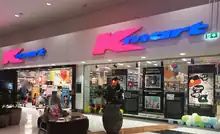 Kmart at Stockland Rockhampton (pictured in 2022) | |
| Type | Subsidiary |
|---|---|
| Industry | Retail |
| Founded | 1969 |
| Headquarters | , |
Number of locations | 500 (2022) |
Area served | Australia & New Zealand |
Key people | Ian Bailey (CEO Department Stores Wesfarmers & Managing Director, Kmart) |
| Revenue |
|
| Total assets |
|
Number of employees | 31,000+ |
| Parent | Kmart Group, a division of Wesfarmers |
| Website | kmart kmart |
The company operates 323 stores across Australia and New Zealand,[1] with its head office located in Mulgrave, Melbourne. Kmart Group, the department store division of Wesfarmers, also owns and operates Target Australia and online retailer Catch.com.au.
History

Kmart Australia Limited was created out of a joint venture between G.J Coles & Coy Limited (Coles) and the S.S. Kresge Company which was the company that operated Kmart stores in the United States. Kresge owned 51% of the common stock in the company and Coles owned the remaining 49%; together they began to develop Kmart stores in Australia in 1968.[2]
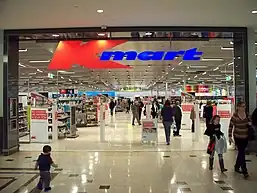
The first store was opened on 30 April 1969 in Burwood East, a suburb of Melbourne. On opening day it was estimated that 40,000 people passed through the checkouts, and the store took in over $97,000 (equivalent to A$1.17 million in 2023) of profit. Because of the number of people that were coming through the store the doors had to be closed 45 minutes after the opening as a safety measure.[3] The store was opened by Mrs HB Cunningham, wife of the president and chairman of the S.S. Kresge Company.[4][5] The site was renovated in 2010 to be a shopping mall known as Burwood One; Kmart still operates a store at the new mall.[6]
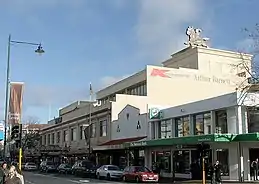
1978-2006: Coles era
In 1978, Kresge (since 1977 known as the "Kmart Corporation") exchanged its 51% stake in Kmart Australia for a 20% stake in G.J. Coles & Coy (later Coles Myer).[2] In November 1994, Kresge/Kmart Corporation divested its 21.5% stake in Coles Myer.[2][7]
Kmart expanded to New Zealand in 1988 with their store in Henderson, a suburb of Auckland.[8]
In 2006, Coles Group announced that Kmart along with BI-LO and the Coles Group liquor brands would eventually be integrated.[9]
The first re-branded store was planned to open in 2007, and 40 stores were reformed into Coles Superstores, mostly former "Super K" stores which had been divided into separate Coles and Kmart stores a decade earlier. By March 2007 the plans for these super centres were deferred pending the sale of all or part of Coles Group,[10] and in August 2007, incoming owners Wesfarmers said super centres would almost certainly not proceed.[11]
In May 2007 Kmart reported a 3.2% drop in sales in the third quarter and an overall drop in sales of 3.9% in its first three quarters.[12]
In July 2007, Wesfarmers announced that they intended to buy the Coles Group for $22 Billion.[13]
2007-present: Wesfarmers ownership
In August 2007, Wesfarmers said it would consider selling all or part of Kmart, or converting some stores to Target.[14][15] Wesfarmers took control of Coles Group in November 2007 and by March 2008 had decided to retain Kmart and invest $300m in the chain over the next five years.[16]
After continuing poor performance in 2009, the 2010 financial year saw a large increase in EBIT, reporting revenue of A$4.02 billion (equivalent to A$4.74 billion in 2023) and an EBIT of A$190 million (equivalent to A$224 million in 2023), an increase in EBIT of over 74%.[17]
This increase was achieved under the leadership of Guy Russo, a former McDonald’s executive who scrapped periodic sales and well-known name brands in favour of drastically reducing prices, streamlining its supply chains, investing in store-branded products and introducing more on-trend pieces.[18]
Kmart also rearranged its stores to eliminate traditional department divisions such as “electronics” in favour of thematic groupings such as “kitchen”, and relocated cash registers from the front of the store to the centre – which was criticised early on,[19] but which was part of a large Wesfarmers investment in store renovations to “make them look like Disneyland”.[20]
On 15 November 2012, Australia's first multi-level Kmart opened in Adelaide's Rundle Mall.[21][22]
By August 2015, Kmart had 214 stores trading across Australia – 52 in New South Wales and the Australian Capital Territory, 47 in Victoria, 41 in Queensland, 23 in Western Australia, 15 in South Australia, five in Tasmania and two in the Northern Territory. There were 20 stores in New Zealand.[23]
In August 2017, Wesfarmers purchased the use of the Kmart brand name in Australia and New Zealand for $100 million, ending a long-term licensing agreement between Coles and Sears for use of the Kmart name.[24][25]
In 2018, all Kmart stores ceased trading of DVDs, CDs, video games, televisions, video game consoles, DVD players and CD players, using the floor space in stores for more children’s products and homewares.[26][27] The home entertainment department had been popular with shoppers, and the decision to scrap it was blamed for Kmart’s profit slump from $415 million in 2017 to as low as $385 million in 2018.[28]
Between 2020 and 2021, 92 Target stores were converted into Kmart locations.[29][30][31]
In July 2023, Kmart and Target Australia announced a merger into one combined business.[32]
Online popularity
Kmart’s own-brand product line Anko, began to more closely follow global design trends, particularly in homewares. Key personnel with international experience included general manager of design Julie Miller Sensini,[33] forecast and design manager Sally Forrest[34] and design manager Kate Hopwood.[35][36]
The low prices, new stylishness and fast turnover of Kmart’s own-brand designs sparked an online subculture of amateur home renovators and decorators, many of whom were suburban women, who used social media to show how they were styling their Kmart purchases and incorporating them into DIY projects that became known as “Kmart hacks”, along the lines of the “IKEA hacks” online community which had existed since 2006.[37]
One of the larger Facebook groups dedicated to sharing “Kmart hacks”, founded in 2015, had 470,000 members in 2021. At that time, a prominent Instagram account @i_heart_kmart had 121,000 followers.[20]
Traditional media coverage praising particular “Kmart hacks” and other clever consumer tips by “Kmart mums” further popularised Kmart as a place to source luxury-styled products at low prices.[38][39]
Revenue
For fiscal year 2020-2021, Kmart Australia reported AU$9.982 billion in revenue with a growth of 8.3% from the previous year.[40]
In the first half of the 2022–2023 fiscal year from July–December 2022, Kmart’s revenue was $5.7 billion – an increase of 24.1% over the previous half year. Over the same period its earnings rose 114% to $475 million.[41]
Store formats
Current store formats
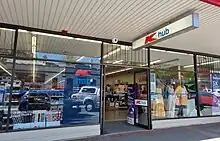
- Kmart stores include merchandise such as home decor and textiles, furniture, apparel and footwear, children’s entertainment and toys, pet supplies, photographic developing, camping and fishing goods, sporting goods, small appliances, storage and home organisation, confectionery, stationery, books, cards and party goods, garden supplies, automotive equipment, lighting, hardware, luggage and cosmetics. In 2013, Kmart began a rollout of new store layouts. Garden plant sections were removed, and back of store areas were cut back. There was an expansion of floorspace to stock and an increase in the height of displays. The stores were given more of a "department store" feel as front-of-store checkouts were replaced with an area to pay at the centre of the store.[18][19]
- Kmart 24 Hour stores are similar to regular Kmart stores apart from being open for 24 hours a day, seven days a week, essentially never closing apart from some public holidays or events.[42] These stores are not visually different apart from a "24 Hours" logo in red appearing next to the Kmart logo.[43]
- Anko is Kmart Australia's house brand: an evolution of the “&Co” branding it had previously used for individual departments such as “Kids&Co”, “Home&Co” and “Clothing&Co”. Introduced in 2019 to celebrate Kmart’s 50th anniversary, Anko also means “A New Kind Of”, representing the company’s changed philosophy since 2008.[44] Anko is also an international brand: Kmart has made arrangements to sell its products in other department stores in countries such as Thailand, Indonesia, India and Canada.[45] Anko is sold exclusively at Zellers in Canada.[46]
- K Hub is the brand being used for smaller rural locations that have replaced Target Country stores.[47][48]
- Kmart Photos originally processed analog film and printed photographs. The centres also allowed Hewlett-Packard's Snapfish customers to collect online orders.[49] The photo centres operated in conjunction with Hewlett-Packard from 2009, after Kmart ended a 30-year partnership with Kodak Australia,[50] to early 2014, when Kmart began a company-wide switch from the Hewlett-Packard powered Minilab system back to a Kodak-powered Minilab system. In 2023, Kmart Photos prints digital images on paper as well as on other items including canvas, mugs and calendars.[51]
Former store formats
- Kmart Tyre and Auto Service (Head Office: Castle Hill, Sydney, New South Wales), was a chain of auto centres that specialises in automotive accessories, car servicing, tyres, check-ups and motor vehicle insurance. Historically, these stores are usually (but not always) attached to a Kmart store. In early 2006 a number of vehicle servicing facilities at Coles Express service stations became Kmart Tyre & Auto Service outlets which was formerly Shell Autoserv and AutoCare network. As of August 2015 there were 246 Kmart Tyre & Auto Service outlets throughout Australia. In August 2018 Wesfarmers announced that it had entered an agreement to sell Kmart Tyre & Auto Service for $350 million to Continental AG.[52] These stores have since been rebranded under the banner MyCar and are no longer affiliated with the Kmart brand.[53][54]
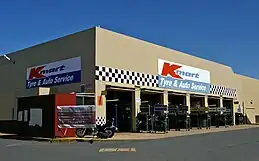
- Kmart Garden Supercentre was specialised in garden, plants and garden furniture. Most of these stores were standalone, "big box" stores in a warehouse format that sold Kmart manufactured or branded outdoor living items. From 1999 to 2007 there were six nurseries, four in Victoria (Chadstone, Campbellfield, Narre Warren, and Taylors Lakes), plus Windsor (Queensland) and Casula (New South Wales). In 2007 Kmart closed its Windsor store and its Chadstone, Casula, Narre Warren and Taylors Lakes stores were renamed into Flower Power. In 2013 Flower Power closed all its nurseries which were formerly Kmart nurseries with the sole exception of the Campbellfield store, (the only store integrated with an existing Kmart store) which was downsized instead, claiming the concept didn't fit its future business strategy. In 2016 this store was also shut down and transformed and it was replaced by Aldi (which opened in August 2017).[55]
- Super Kmart was a hypermarket concept launched in the 1983 financial year with four stores (two in New South Wales and one each in Western Australia and Victoria). The concept consisted of approximately 9,000 square metres comprising a Kmart discount department store and supermarket within one retail space.[56] Super Kmart was expanded to 34 locations by 1990 when the concept was discontinued and the stores split into separate Kmart discount department stores and Coles New World supermarkets. However at some former Super Kmart locations it took several years for the split wall to be installed between Kmart & Coles.[57] The stores had been operated under an independent division and the cost of duplicating administration functions as well as lower sales results compared to separate Kmart and Coles New World supermarket lead to the discontinuation of the concept.[58]
- Holly's Restaurant During the 1980s and 1990s, every Kmart store had a Holly's in-store restaurant. Starting from around the mid-late 1990’s, they were progressively shut down across the country, with the last Holly's at Kmart Horsham closing down on 25 June 2010.
- Girl Xpress was planned as a clothing store chain for young urban women. A concept store was trialled at Burwood East, Victoria from 2005, however was later discontinued. Girl Xpress has been retained however, as a Kmart house brand.
- Kmart Clearance Centre was a briefly trialled clearance centre concept at Ringwood from November 2006 until June 2007.
- Kmart Food were supermarkets initially opened adjacent to Kmart discount department stores. By June 1975 there were 21 Kmart Food supermarkets[59] The supermarkets were rebranded as Coles New World supermarkets during the 1976 financial year.[60]
- ColMart was a joint Coles New World supermarket and variety store located in Whyalla, South Australia in the 1980s.[61]
Community
Kmart Wishing Tree Appeal
Since 1988, Kmart and The Salvation Army have collected over five million gifts from customers, which are then distributed to those in need.[62][63] The concept for the Kmart Wishing Tree Appeal first came about when Eve Mitchell, a team member from the Kmart store in Noarlunga suggested Kmart use its network of stores as gift collection points, assisting charity groups at Christmas.[64] Over 464,000 gifts were donated to the 2010 appeal.[65]
See also
- Kmart, operated by Transformco.
- Big W, one of Kmart's main competitors.
References
- "2021 Annual Report" (PDF). Archived (PDF) from the original on 18 December 2021. Retrieved 18 December 2021.
- "Sears Holdings: Kmart Timeline (US)". Archived from the original on 29 September 2011. Retrieved 18 August 2011.
- "Hundreds of bargain-hunters queue to shop in K-Mart". The Age. 1 May 1969. p. 13. Archived from the original on 7 December 2021. Retrieved 19 April 2010.
- "Coles History 1969". Archived from the original on 7 December 2021. Retrieved 2 April 2017.
- "Kmart Australia: The Kmart Story". Archived from the original on 8 August 2011. Retrieved 12 August 2011.
- Hopkins, Philip (20 October 2010). "Kmart's first home gets special treatment". The Age. ProQuest 759084586.
- "21.5% Stake in Coles Myer of Australia Is Ended". The New York Times. 5 November 1994. Archived from the original on 23 January 2018. Retrieved 22 January 2018.
- "Kmart celebrates 20 years in New Zealand". Scoop. 14 October 2008. Archived from the original on 22 January 2018. Retrieved 22 January 2018.
- "Strategy Update: Driving Value for our Shareholders" (PDF). Coles Group (News Release). 21 September 2006. Archived from the original (PDF) on 2 September 2007. Retrieved 9 August 2007.
- "Coles defers supercentre strategy as sell-off looms". The New Zealand Herald. 20 March 2007. Archived from the original on 29 September 2007. Retrieved 9 August 2007.
- "'Mini-Kmarts' to hold off rivals". Australian Financial Review. 20 August 2007. p. 15.
- "Coles Group 2007 third quarter sales" (PDF). Coles Group (News Release). 17 May 2007. Archived from the original (PDF) on 28 September 2007.
- "Coles sold for $22 billion". 2 July 2007. Archived from the original on 6 July 2007.
- "Wesfarmers plans Coles investment, restructuring". Reuters. 16 August 2007. Archived from the original on 8 January 2016. Retrieved 8 September 2011.
- "Wesfarmers chief flags Kmart name change". The Sydney Morning Herald. 11 November 2007. Retrieved 12 April 2023.
- "Wesfarmers puts $300m into Kmart". The Age, Melbourne. 20 March 2008. Archived from the original on 7 November 2012. Retrieved 8 September 2011.
- "Wesfarmers 2010 Full Year Report" (PDF). Archived (PDF) from the original on 20 March 2012. Retrieved 12 August 2011.
- Powell, Dominic (7 February 2020). "How Kmart became the 'cool mum' of Australia's discount retailers". The Sydney Morning Herald. Archived from the original on 21 July 2020. Retrieved 21 July 2020.
- McCauley, Dana (2 September 2017). "Kmart's new store layout is driving people crazy". News.com.au. Retrieved 26 March 2023.
- Adams, David (27 June 2021). "In Australia, a former McDonald's executive reinvented Kmart. Now Kmart 'influencers' are some of the most prolific creators on the Aussie internet". Business Insider. Retrieved 26 March 2023.
- "Our toy story signals battle in city's mall". The Advertiser. Adelaide. 21 October 2011. Archived from the original on 22 October 2011. Retrieved 10 May 2012.
- "Kmart Supplier Update". Archived from the original on 15 May 2013. Retrieved 2 August 2012.
- "Wesfarmers 2015 supplementary information". Archived from the original on 7 September 2015. Retrieved 1 September 2015.
- "License Agreement between Kmart Corporation and Kmart Australia Limited". www.sec.gov. Archived from the original on 15 August 2018. Retrieved 15 August 2018.
- "Wesfarmers 2017 annual report" (PDF). p. 132. Archived (PDF) from the original on 15 April 2018. Retrieved 15 August 2018.
- Fenech, Stephen (29 June 2018). "Is Kmart's decision to stop selling DVDs the beginning of the end for physical media - Tech Guide". www.techguide.com.au. Retrieved 26 March 2023.
- Mitchelson, Alana (28 June 2018). "Kmart Australia to stop selling DVDs, CDs and Blu-rays". The New Daily. Retrieved 26 March 2023.
- Hall, James (14 January 2019). "Kmart's decision to bin selling DVDs and CDs blamed for first half profit slump". News.com.au. Retrieved 26 March 2023.
- Chalmers, Stephanie (21 May 2020). "Target shuts up to 75 stores and converts others to Kmart, putting up to 1,300 jobs at risk". ABC News (on-line). Retrieved 22 May 2020.
- "Which Target stores are closing, rebranding as Kmart?". www.9news.com.au. Retrieved 13 October 2021.
- "Target Business Update". Target. Retrieved 14 January 2023.
- Cao, Sean (24 July 2023). "Wesfarmers to merge back ends of Target, Kmart businesses". Inside Retail. Retrieved 25 July 2023.
- Andersen, Margot (4 June 2019). "Julie Miller Sensini". Insync Networking Group. Retrieved 26 March 2023.
- "Kmart is now styling customers - Ragtrader". www.ragtrader.com.au. 27 July 2016. Retrieved 26 March 2023.
- Carroll, Chris (9 March 2018). "Behind the Scenes with the Kmart Design Team". Retrieved 26 March 2023.
- Brown, Vanessa (6 August 2018). "Meet the woman behind discount retailer's cheap homewares". News.com.au. Retrieved 26 March 2023.
- "Jules Yap and how she started IKEA hacking". IKEA Hackers. Retrieved 26 March 2023.
- Boyd, Rebecca (9 August 2019). "Our 15 best Kmart hacks to try this weekend". Better Homes and Gardens. Retrieved 26 March 2023.
- Cleal, Olivia (25 December 2022). "The unlikely $8.50 buy to organise your pantry, plus the top Kmart hacks of 2022". 7NEWS. Retrieved 26 March 2023.
- "2021 Full-year results briefing presentation".
- Bencic, Emily (16 February 2023). "Kmart drives profit growth for Wesfarmers". Appliance Retailer. Retrieved 26 March 2023.
- "Man asks Kmart customers why they're shopping at 1am. The confessions will surprise you". 7NEWS. 18 March 2022. Retrieved 26 March 2023.
- "WA's first 24-hour department store opens". ABC News. 26 November 2014. Retrieved 25 January 2022.
- Paine, Hannah (19 January 2021). "Kmart Australia shoppers stunned by meaning behind Anko brand". News.com.au. Retrieved 26 March 2023.
- "Kmart looks abroad to satiate growth aspirations - Inside Retail". Inside Retail. 7 June 2018. Archived from the original on 1 December 2018. Retrieved 30 November 2018.
- Patterson, Craig (22 March 2023). "Inside Zellers 2.0 and its Newly Secured In-House Brand 'Anko' [Photos/Analysis]". Retail Insider. Retrieved 31 March 2023.
- "Welcome to K hub stores". www.kmart.com.au. 2020. Archived from the original on 20 November 2020. Retrieved 18 December 2020.
- "New Kmarts opening in Australia". www.realcommercial.com.au. Retrieved 26 March 2023.
- "Kmart Online Photo Centre". Archived from the original on 14 July 2011. Retrieved 28 July 2011.
- "Kmart to launch HP Photo Centre 4.0 nationwide". 18 August 2009. Archived from the original on 17 October 2011. Retrieved 28 July 2011.
- "Kmart Photos". Kmart Photos. Retrieved 26 March 2023.
- "Agreement to sell Kmart Tyre and Auto Service" (PDF). Archived (PDF) from the original on 13 March 2019. Retrieved 29 November 2019.
- "Continental to acquire Kmart Tyre and Auto Service". Practical Motoring. 13 August 2018. Archived from the original on 22 February 2019. Retrieved 22 February 2019.
- "Wesfarmers sells Kmart Tyre and Auto Service for $350m". Australian Financial Review. 12 August 2018. Archived from the original on 22 February 2019. Retrieved 22 February 2019.
- "Kmart Garden Super Centre Announcement" (PDF). Archived from the original (PDF) on 17 February 2011. Retrieved 7 September 2011.
- G.J Coles & Co Limited Annual Report 1983.
- Coles Myer Ltd Annual Report 1989.
- Coles Myer Limited Annual Report 1989.
- G.J Coles & Co Limited Annual Report 1975.
- G.J Coles & Co Limited Annual Report 1976.
- "Whyalla News". Victor Harbour Times. 4 April 1984.
- "Salvation Army – Kmart Wishing Tree Appeal". Archived from the original on 28 September 2011. Retrieved 1 August 2011.
- "Five Millionth Gift" (PDF). Archived from the original (PDF) on 3 April 2011. Retrieved 1 August 2011.
- "About the Kmart Wishing Tree Appeal". Archived from the original on 16 November 2011. Retrieved 1 August 2011.
- "Kmart Wishing Tree Appeal". Archived from the original on 15 November 2011. Retrieved 1 August 2011.